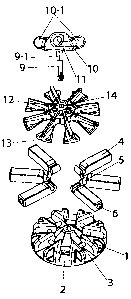Une partie des informations de ce site Web a été fournie par des sources externes. Le gouvernement du Canada n'assume aucune responsabilité concernant la précision, l'actualité ou la fiabilité des informations fournies par les sources externes. Les utilisateurs qui désirent employer cette information devraient consulter directement la source des informations. Le contenu fourni par les sources externes n'est pas assujetti aux exigences sur les langues officielles, la protection des renseignements personnels et l'accessibilité.
L'apparition de différences dans le texte et l'image des Revendications et de l'Abrégé dépend du moment auquel le document est publié. Les textes des Revendications et de l'Abrégé sont affichés :
| (12) Demande de brevet: | (11) CA 2745545 |
|---|---|
| (54) Titre français: | CADRE POUR TENTES ET PARASOLS DE CAMPING AVEC SYSTDME DE VERROUILLAGE OSCILLANT |
| (54) Titre anglais: | FRAMWORK FOR CAMPING TENTS AND PARASOLS WITH AN OSCILLATING SECURE LOCKING SYSTEM |
| Statut: | Réputée abandonnée et au-delà du délai pour le rétablissement - en attente de la réponse à l’avis de communication rejetée |
| (51) Classification internationale des brevets (CIB): |
|
|---|---|
| (72) Inventeurs : |
|
| (73) Titulaires : |
|
| (71) Demandeurs : |
|
| (74) Agent: | MARKS & CLERK |
| (74) Co-agent: | |
| (45) Délivré: | |
| (22) Date de dépôt: | 2011-07-07 |
| (41) Mise à la disponibilité du public: | 2013-01-07 |
| Licence disponible: | S.O. |
| Cédé au domaine public: | S.O. |
| (25) Langue des documents déposés: | Anglais |
| Traité de coopération en matière de brevets (PCT): | Non |
|---|
| (30) Données de priorité de la demande: | S.O. |
|---|
The invention relates to a framework for camping tents and parasols with an
oscillating secure locking system allowing the folding and extending thereof
and having
a central part or joint with radial grooves for a prismatic arm in
correspondence with
each groove. Each arm has at its inner end a channel for the articulated
coupling on
the transverse axis of the respective groove, allowing the positioning of the
arms and of
the respective rods coupled to the arms. The cloth, the central part and the
oscillating
secure locking part are secured by means of a stem forming part of a cap with
a hole
for a pull cord for extending the tent or parasol, the stem of the cap being
housed in a
central hole of the central part itself.
Note : Les revendications sont présentées dans la langue officielle dans laquelle elles ont été soumises.
Note : Les descriptions sont présentées dans la langue officielle dans laquelle elles ont été soumises.

2024-08-01 : Dans le cadre de la transition vers les Brevets de nouvelle génération (BNG), la base de données sur les brevets canadiens (BDBC) contient désormais un Historique d'événement plus détaillé, qui reproduit le Journal des événements de notre nouvelle solution interne.
Veuillez noter que les événements débutant par « Inactive : » se réfèrent à des événements qui ne sont plus utilisés dans notre nouvelle solution interne.
Pour une meilleure compréhension de l'état de la demande ou brevet qui figure sur cette page, la rubrique Mise en garde , et les descriptions de Brevet , Historique d'événement , Taxes périodiques et Historique des paiements devraient être consultées.
| Description | Date |
|---|---|
| Le délai pour l'annulation est expiré | 2015-07-07 |
| Demande non rétablie avant l'échéance | 2015-07-07 |
| Réputée abandonnée - omission de répondre à un avis sur les taxes pour le maintien en état | 2014-07-07 |
| Exigences relatives à la nomination d'un agent - jugée conforme | 2013-10-23 |
| Inactive : Lettre officielle | 2013-10-23 |
| Inactive : Lettre officielle | 2013-10-23 |
| Exigences relatives à la révocation de la nomination d'un agent - jugée conforme | 2013-10-23 |
| Demande visant la nomination d'un agent | 2013-10-17 |
| Demande visant la révocation de la nomination d'un agent | 2013-10-17 |
| Demande publiée (accessible au public) | 2013-01-07 |
| Inactive : Page couverture publiée | 2013-01-06 |
| Inactive : Réponse à l'art.37 Règles - Non-PCT | 2012-07-05 |
| Inactive : CIB en 1re position | 2011-10-24 |
| Inactive : CIB attribuée | 2011-10-24 |
| Inactive : Demande sous art.37 Règles - Non-PCT | 2011-08-22 |
| Demande reçue - nationale ordinaire | 2011-07-22 |
| Inactive : Certificat de dépôt - Sans RE (Anglais) | 2011-07-22 |
| Date d'abandonnement | Raison | Date de rétablissement |
|---|---|---|
| 2014-07-07 |
Le dernier paiement a été reçu le 2013-07-02
Avis : Si le paiement en totalité n'a pas été reçu au plus tard à la date indiquée, une taxe supplémentaire peut être imposée, soit une des taxes suivantes :
Les taxes sur les brevets sont ajustées au 1er janvier de chaque année. Les montants ci-dessus sont les montants actuels s'ils sont reçus au plus tard le 31 décembre de l'année en cours.
Veuillez vous référer à la page web des
taxes sur les brevets
de l'OPIC pour voir tous les montants actuels des taxes.
| Type de taxes | Anniversaire | Échéance | Date payée |
|---|---|---|---|
| Taxe pour le dépôt - générale | 2011-07-07 | ||
| TM (demande, 2e anniv.) - générale | 02 | 2013-07-08 | 2013-07-02 |
Les titulaires actuels et antérieures au dossier sont affichés en ordre alphabétique.
| Titulaires actuels au dossier |
|---|
| EOLO SPORT INDUSTRIAS, S.A. |
| Titulaires antérieures au dossier |
|---|
| ALEJANDRO PRIETO ESTEBANEZ |